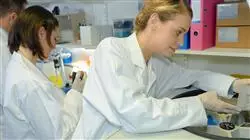University certificate
Scientific endorser

The world's largest faculty of medicine”
Introduction to the Program
A complete program that will help you keep up to date with the latest techniques in MBA in Clinical Trials Management and Monitoring.
Continuous research in the development of new drugs is extremely important for advances in the treatment of new diseases, pathologies for which there is still no cure or those for which resistance to known treatments is being created.

Increased investment in healthcare research to improve patient quality of life means that more and more specialists are needed in this field. Hence the importance of expanding academic knowledge in all research areas. The Professional Master's Degree in Clinical Trial Management and Monitoring is a program developed by professionals with extensive professional experience in the field of clinical trials who are currently working in this area.
The teaching team has made a careful selection of topics, useful for experienced professionals working in the healthcare field. This program employs the most advanced web 2.0 communication tools, which allow working methods that promote interaction among professionals, information exchange and constant and active participation.
Specifically, this Professional Master's Degree guides the health professional through the Clinical Trials Management and Monitoring, via a theoretical and practical course provided by professionals with extensive experience.
Thanks to this Professional Master's Degree, physicians will have the necessary tools and the ability to successfully improve their professional practice in the vast world of Clinical Trials, to work on key skills such as knowledge of the day-to-day realities and language of healthcare, to take on responsibility for the monitoring and supervision of clinical trial activities, as well as developing communication skills to promote effective teamwork.
Expand your knowledge through thisProfessional master’s degree in MBA in Clinical Trials Management and Monitoring which will enable you to hone your skills until you achieve excellence in this field”
This Professional master’s degree in MBA in Clinical Trials Management and Monitoring contains the most complete and up-to-date scientific program on the market. The most important features include:
- The examination of case studies presented by experts in Clinical Trials
- The graphic, schematic, and practical contents with which they are created, provide scientific and practical information on the disciplines that are essential for professional practice
- New developments in Clinical Trials
- Practical exercises where the self-assessment process can be carried out to improve learning
- Special emphasis on innovative methodologies in Clinical Trials
- Theoretical lessons, questions to the expert, debate forums on controversial topics, and individual reflection assignments
- Content that is accessible from any fixed or portable device with an Internet connection
This Professional master’s degree is the best investment you can make when selecting an up-to-date program for two reasons: In addition to updating your knowledge in MBA in Clinical Trials Management and Monitoring, you will obtain a Professional master’s degree from TECH Global University
The teaching staff includes medical professionals who bring their experience to this program, as well as renowned specialists from leading societies and prestigious universities.
The multimedia content, developed with the latest educational technology, will provide the professional with situated and contextual learning, i.e., a simulated environment that will provide immersive education programmed to learn in real situations.
This program is designed around Problem-Based Learning, whereby the professional must try to solve the different professional practice situations that arise throughout the program. For this purpose, professors will be assisted by a innovative interactive video system developed by renowned and experienced experts in the field ofMBA in Clinical Trials Management and Monitoring
Do not hesitate to take this educational program with us. You will find the best teaching material with virtual lessons"

This 100% online program will allow you to balalnce your studies with your professional work while increasing your knowledge in this field"
Why study at TECH?
TECH is the world’s largest online university. With an impressive catalog of more than 14,000 university programs available in 11 languages, it is positioned as a leader in employability, with a 99% job placement rate. In addition, it relies on an enormous faculty of more than 6,000 professors of the highest international renown.

Study at the world's largest online university and guarantee your professional success. The future starts at TECH”
The world’s best online university according to FORBES
The prestigious Forbes magazine, specialized in business and finance, has highlighted TECH as “the world's best online university” This is what they have recently stated in an article in their digital edition in which they echo the success story of this institution, “thanks to the academic offer it provides, the selection of its teaching staff, and an innovative learning method aimed at educating the professionals of the future”
A revolutionary study method, a cutting-edge faculty and a practical focus: the key to TECH's success.
The most complete study plans on the university scene
TECH offers the most complete study plans on the university scene, with syllabuses that cover fundamental concepts and, at the same time, the main scientific advances in their specific scientific areas. In addition, these programs are continuously being updated to guarantee students the academic vanguard and the most in-demand professional skills. In this way, the university's qualifications provide its graduates with a significant advantage to propel their careers to success.
TECH offers the most comprehensive and intensive study plans on the current university scene.
A world-class teaching staff
TECH's teaching staff is made up of more than 6,000 professors with the highest international recognition. Professors, researchers and top executives of multinational companies, including Isaiah Covington, performance coach of the Boston Celtics; Magda Romanska, principal investigator at Harvard MetaLAB; Ignacio Wistumba, chairman of the department of translational molecular pathology at MD Anderson Cancer Center; and D.W. Pine, creative director of TIME magazine, among others.
Internationally renowned experts, specialized in different branches of Health, Technology, Communication and Business, form part of the TECH faculty.
A unique learning method
TECH is the first university to use Relearning in all its programs. It is the best online learning methodology, accredited with international teaching quality certifications, provided by prestigious educational agencies. In addition, this disruptive educational model is complemented with the “Case Method”, thereby setting up a unique online teaching strategy. Innovative teaching resources are also implemented, including detailed videos, infographics and interactive summaries.
TECH combines Relearning and the Case Method in all its university programs to guarantee excellent theoretical and practical learning, studying whenever and wherever you want.
The world's largest online university
TECH is the world’s largest online university. We are the largest educational institution, with the best and widest online educational catalog, one hundred percent online and covering the vast majority of areas of knowledge. We offer a large selection of our own degrees and accredited online undergraduate and postgraduate degrees. In total, more than 14,000 university degrees, in eleven different languages, make us the largest educational largest in the world.
TECH has the world's most extensive catalog of academic and official programs, available in more than 11 languages.
Google Premier Partner
The American technology giant has awarded TECH the Google Google Premier Partner badge. This award, which is only available to 3% of the world's companies, highlights the efficient, flexible and tailored experience that this university provides to students. The recognition as a Google Premier Partner not only accredits the maximum rigor, performance and investment in TECH's digital infrastructures, but also places this university as one of the world's leading technology companies.
Google has positioned TECH in the top 3% of the world's most important technology companies by awarding it its Google Premier Partner badge.
The official online university of the NBA
TECH is the official online university of the NBA. Thanks to our agreement with the biggest league in basketball, we offer our students exclusive university programs, as well as a wide variety of educational resources focused on the business of the league and other areas of the sports industry. Each program is made up of a uniquely designed syllabus and features exceptional guest hosts: professionals with a distinguished sports background who will offer their expertise on the most relevant topics.
TECH has been selected by the NBA, the world's top basketball league, as its official online university.
The top-rated university by its students
Students have positioned TECH as the world's top-rated university on the main review websites, with a highest rating of 4.9 out of 5, obtained from more than 1,000 reviews. These results consolidate TECH as the benchmark university institution at an international level, reflecting the excellence and positive impact of its educational model.” reflecting the excellence and positive impact of its educational model.”
TECH is the world’s top-rated university by its students.
Leaders in employability
TECH has managed to become the leading university in employability. 99% of its students obtain jobs in the academic field they have studied, within one year of completing any of the university's programs. A similar number achieve immediate career enhancement. All this thanks to a study methodology that bases its effectiveness on the acquisition of practical skills, which are absolutely necessary for professional development.
99% of TECH graduates find a job within a year of completing their studies.
Professional Master's Degree MBA in Clinical Trials Management and Monitoring
The continuous appearance of new diseases, added to the progressive strengthening of already known pathologies, has given way to the emergence of an endless number of new projects, studies and pharmacological research. This situation has led the area of clinical trials to stand out as one of the most relevant and important fields of modern medicine at present, thus generating an extensive field of occupational opportunities in the sector. Understanding the need for academic updating that accompanies the growing interest of physicians for access to this important labor niche, in TECH Global University we have designed our Professional Master's Degree MBA in Clinical Trials Management and Monitoring. In this postgraduate program, special emphasis will be placed on the new methodologies used in the design process of phase 1 clinical trials. Likewise, the following concepts will be updated: the particularities and elements to be taken into account in the structuring and planning of clinical trial processes of equivalence and non-inferiority; and the identification of the new procedures and protocols for the authorization and registration of drugs and medical devices.
Study an online Professional Master's Degree MBA in Clinical Trials Management and Monitoring
The large number of legislative and regulatory regulations surrounding the management of clinical trials require the presence of specialized professionals with a high degree of expertise and preparation for their proper management and monitoring. In our Professional Master's Degree you will approach the management of clinical trials from the identification of the major challenges surrounding the development of the sector, contemplating, in turn, the modernization of the professional with respect to the following aspects: the identification of the new criteria to be considered in the selection of subjects and patients for the conduct of a clinical trial and the possibilities of development present in the implementation of clinical trials in modern urology services.







